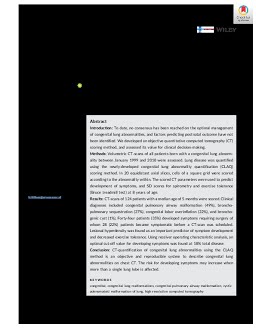2020-08-18
Congenital lung abnormality quantification by computed tomography: The CLAQ method
Publication
Publication
Introduction: To date, no consensus has been reached on the optimal management of congenital lung abnormalities, and factors predicting postnatal outcome have not been identified. We developed an objective quantitative computed tomography (CT) scoring method, and assessed its value for clinical decision-making. Methods: Volumetric CT-scans of all patients born with a congenital lung abnormality between January 1999 and 2018 were assessed. Lung disease was quantified using the newly-developed congenital lung abnormality quantification (CLAQ) scoring method. In 20 equidistant axial slices, cells of a square grid were scored according to the abnormality within. The scored CT parameters were used to predict development of symptoms, and SD scores for spirometry and exercise tolerance (Bruce treadmill test) at 8 years of age. Results: CT-scans of 124 patients with a median age of 5 months were scored. Clinical diagnoses included congenital pulmonary airway malformation (49%), bronchopulmonary sequestration (27%), congenital lobar overinflation (22%), and bronchogenic cyst (1%). Forty-four patients (35%) developed symptoms requiring surgery of whom 28 (22%) patients became symptomatic before a CT-scan was scheduled. Lesional hyperdensity was found as an important predictor of symptom development and decreased exercise tolerance. Using receiver operating characteristic analysis, an optimal cut-off value for developing symptoms was found at 18% total disease. Conclusion: CT-quantification of congenital lung abnormalities using the CLAQ method is an objective and reproducible system to describe congenital lung abnormalities on chest CT. The risk for developing symptoms may increase when more than a single lung lobe is affected.
| Additional Metadata | |
|---|---|
| , , , , | |
| doi.org/10.1002/ppul.25032, hdl.handle.net/1765/129859 | |
| Pediatric Pulmonology | |
|
Hermelijn, S.M. (Sergei M.), Dragt, O.V. (Olivier V.), Bosch, J.J. (Jochem J.), Hijkoop, A., Riera, L. (Luis), Ciet, P., … Tiddens, H. (2020). Congenital lung abnormality quantification by computed tomography: The CLAQ method. Pediatric Pulmonology. doi:10.1002/ppul.25032 |
|

